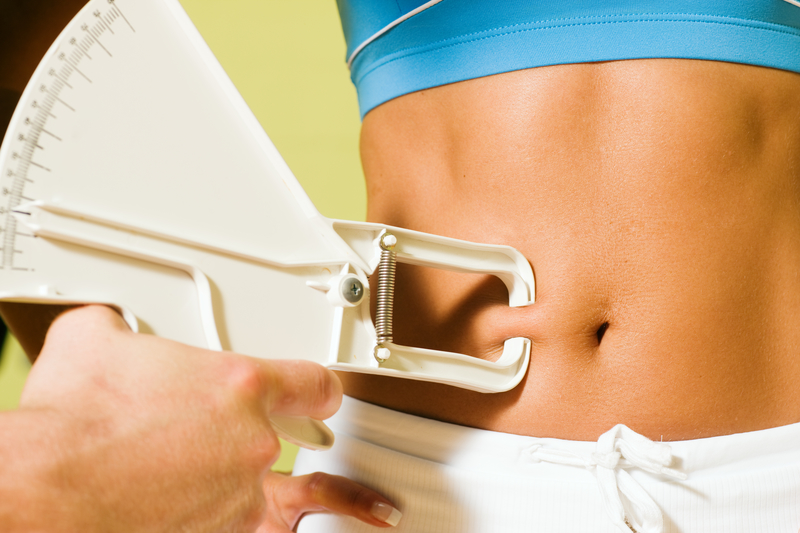Ask the Coaches: What Is Your Ideal Body Fat Percentage?

I have noticed that my clothes are fitting looser, so at least there’s that. But considered that I used to be pretty sedentary and my diet was pretty hit or miss, I thought I’d have dropped at least 10 to 15 pounds by now. It’s been over three months since I got really serious, and I haven’t missed a workout yet.
Someone at the gym told me to forget about the scale and watch my body fat percentage instead. What is that, and how do I calculate it? Should I really skip the scale? Is there a better way to keep track of my results?
Feeling Stuck,
Sarah
A: Thanks for your great question, Sarah. I can certainly understand your frustration. But no matter what you do, please don’t give up. From what you described, I think you’ve actually had even better results than you think, despite that stubborn scale suggesting otherwise.
While you don’t necessarily need to toss out the scale completely, your gym buddy has shared a great idea with you. I’m glad you’re seeking to learn more about your body fat percentage and how to track it.
Should You Ditch the Scale?
A lot of people rely exclusively on the scale to determine progress, and that isn’t a good idea, especially if you exercise. Here’s why: The number on the scale doesn’t tell you anything about your distribution of weight. For example, it can’t tell you how much fat you have, if you’re losing fat, or if you’re gaining quality weight in the form of calorie-burning lean muscle, which helps you look, feel, and move your best.
You see, when you combine exercise (especially regular weight training, like you’re doing) with a nutritious, portion-controlled plan like the Mediterranean Diet, it’s quite possible that you’re not just going to lose body fat weight (which is the goal), you could very well be gaining lean, calorie-scorching muscle mass. (The absolute best result!)
For example, you might gain a few pounds of “good” weight while losing several “unwanted” pounds (of fat), and in this case, the net weight loss depicted on the scale doesn’t even come close to telling you about how your body is changing. In fact, the increase in lean muscle could completely overshadow any fat loss. This is one reason why it’s so important to assess body fat percentage.
To put it simply, your body fat percentage is your proportion of body fat to your total body mass (i.e., scale weight). So, if you weigh 180 pounds and have 45 pounds of fat, you have 25% body fat.
As you lose fat or gain muscle, your body fat percentage changes. It also changes as you gain fat or lose muscle.
Let’s say you have started working out with weights, walking regularly, and consuming a healthier, portion-controlled diet (as you have). You may not see much in the way of a scale weight change, at least not as much as you expect, but your body fat percentage may tell a very different story. For example, if your scale weight drops by only 5 pounds but your lean mass increases by 5 pounds, that means you’ve lost an impressive 10 pounds of fat while gaining metabolism-boosting muscle mass.
Looking at the same example above, you would now weigh 175 pounds but with 35 pounds of fat which means you’re down to 20% fat. Pretty cool, right?
Body Fat Calculations
So how much fat should you have? Here’s a quick look at body fat percentages and what they mean for both women and men:
Women:
- Essential fat: 10 – 12%
- Athlete: 13 – 20%
- Fit: 21 – 24%
- Normal: 25 – 34%
- Obese: 35%+
Men:
- Essential fat: 4 – 6%
- Athlete: 7 – 10%
- Fit: 11 – 16%
- Normal: 17 – 24%
- Obese: 25%+
Just as body fat percentage can get too high (in the obese range), it can also go too low (in the essential range). Essential fat is vital in our bodies as it’s part of nerve cells, brain tissue, joints, major organs (including the heart and intestines), and on the pads of the hands and feet. A certain level of body fat is required for us to live.
Men can’t get lower in body fat than 4 to 5%, and the leanest women can get is 10 to 12% as they carry necessary additional fat in their breasts, hips, thighs, and butts. Losing too much fat can cause the heart to stop, organs to fail, hormones to go haywire, or lead to a coma. And the body will protect itself by breaking down muscle tissue and organs for energy if you drop too low.
Maintaining the super-low body fat levels of an athlete is possible, but for most people, it takes a lot of effort, excessive amounts of exercise, and highly restrictive food intake—arguably, obsessive levels—and isn’t necessary to be healthy.
It’s been found, for instance, that the benefits of fat loss drop after men hit around 15% body fat and women reach about 25% body fat. In other words, dropping your body fat percentage below the “fit” category is more about wanting to look or perform a certain way than enjoying greater health. That’s not to say it isn’t a valid reason—it can be a great reason. After all, we all want to look good. It just may not be necessary for your overall health.
Once you hit the normal range, and certainly once you’re obese, losing body fat is not just about how you look, it is about improving health and potentially longevity.
Finding Your Body Fat Set Point
The “set point” is the body weight/body fat point that your body likes and defends by way of hormones, hunger, behavior, and mindset to help you maintain strength levels, energy, and overall enjoyment of your fitness lifestyle. Everyone has a slightly different set point based on their personal genetics, activity levels, and diet.
Once you are in the range your body likes, it’s like setting “cruise control.” You may need to speed up to pass a slow car or slow down to go through town, but for the most part, you can just maintain what you’re doing to stay on track.
Calculating Body Fat Percentage: 5 Ways
As you may have guessed, you can’t determine your body fat percentage accurately with a typical scale. Even with a “special” scale that attempts to assess body composition, you likely won’t get the most accurate results. In fact, if you use three different methods or just use three different calculations, you’ll very likely get three different results.
1. Bioelectrical Impedance Analysis
The most accessible way to take your body fat percentage is with a scale or a handheld device that uses “bioelectrical impedance analysis,” or BIA. These devices use your body’s resistance to a light electrical current. Because muscle conducts electricity well (it’s over 70% water) and fat doesn’t (it doesn’t contain nearly as much water), the leaner you are, the easier it is for the electrical current to run through.
While devices that utilize BIA technology are the most convenient, they’re also typically inaccurate and unreliable, which is arguably most important.
That’s because as the current goes through the body, it searches for the easiest paths and may skip past the subcutaneous fat (that is, the fat directly under the skin) or even entire body parts. Those devices that you stand on may measure just your legs, for example, skipping your torso and upper body. Handheld devices may only provide results for the torso and arms, skipping the legs.
There can also be issues with the formulas these devices use. Plus, results can vary drastically depending on how hydrated you are or if you’ve eaten or not. Even taking a measurement before vs. after a workout can affect the results.
Many experts consider these types of devices to be virtually useless.
2. Skinfold Testing
One of the oldest methods involves the use of calipers that measure the thickness of skinfolds at various locations of the body. The skinfold measurements are then added together and entered into an equation to estimate body fat percentage.
Depending on who is doing the pinching and how experienced they are, they can grab too much or too little skin, which can drastically change the readings, so it’s important to find someone who can consistently do the testing.
There are also so many different equations—and some are less accurate than others. In some cases, the measurements differed by as much as 15%. 1, 2, 3 To help put that into perspective, someone with 20% body fat could get a reading of as low as 5% or as high as 35%. That’s just crazy!
3. DEXA (Dual Energy X-Ray Absorptiometry)
You may have heard of DEXA, which is often used to measure bone density. These high-end machines are typically only in labs and clinical settings. And while you might think these would represent the best of the best, they aren’t always the most accurate either. 2 Studies have found these can be off by up to 10% depending on the machine and manufacturer, the person’s gender, size, hydration, and even disease state. 4
4. Bod Pod
At one time, this was considered the absolute best, most accurate body composition measurement device. It is similar to hydrostatic weighing (which uses water displacement to measure body composition), but instead, it uses air displacement. Yet again, many things can affect the accuracy of these machines. Minor variations like facial hair, moisture, and body temperature, as well as the clothing worn can change readings by up to 15%. 5, 6
I hope you’re not getting even more frustrated thinking the scale doesn’t work and body fat measuring methods aren’t all that accurate either. There is one method that has been shown to be a true “gold standard” for body fat calculation that is highly accurate. And no, it doesn’t involve you being a cadaver.
5. 4-Compartment Analysis
With several testing methods, researchers are able to separate body weight into categories:
- Bone mass via DEXA
- Water via deuterium dilution
- Body density via hydrostatic weighing
By combining all of these methods with a meticulous formula, researchers are able to accurately and consistently estimate body fat percentage.
If you haven’t caught it yet, though, there’s a big drawback. A team of scientists are needed for the 4-compartment analysis, so this is sadly not realistic for the vast majority of us.
So where does that leave us?
How to Track Your Body Fat Percentage
It turns out there’s no single solution to tracking body fat percentage. Instead, it takes a set of tools. Here’s how to keep track of your own results from the privacy of your own home:
- Jump on the Scale: whether you check daily or weekly, measuring your weight (when combined with the tools below) helps keep you in tune with what is happening with your body. After just a few weeks or months, you’ll learn how your body weight fluctuates with stress, hormones, hydration, exercise, etc.
- Take a pinch with single-site body fat calipers: human error is the biggest drawback of calipers, so practice first to ensure you consistently use the same pressure and location for your skinfold measurements. Then use the same set of calipers, in the same place, again at the same time of day. This can be done weekly. If the skinfolds are getting smaller, you’re losing fat; thicker, you’re gaining fat. Single-site testing methods can be surprisingly accurate, and you don’t have to find a formula (or have someone else test the hard-to-reach body parts likely your upper back or the back of your arm).
- Track your size with a tape measure: another good measurement to keep track of is your waist. Using a flexible tape measure, you can watch to see if your waist expands or shrinks with your workouts and diet to help you keep track of the bigger picture. You can also measure other body parts to watch your biceps grow or your thighs shrink, for example—which can both be motivating.
- Take a selfie: yes, you do see yourself in the mirror every day, but to keep track of your progress, take a picture. Trust us on this. You’ll be able to see your progress over time as you lose fat and look more toned. Again, shoot to take pictures at the same time with the same lighting and angles.
The Ideal Body Fat Percentage
There is no ideal body fat percentage for men or women. Rather, it’s better to look at ranges based on your personal goals. The average body fat percentage for men is 28%, and for women, it’s 40%. These levels are about twice as high as they probably should be.
What’s a good range for both health and good looks? For men, it’s around 11 to 16%, and for women, it’s 16 to 24% again depending on your personal preference, goals, and set point.
If your goal is to see your abs, then for the guys, you’re usually looking at getting under 10% body fat, and gals can expect to start seeing them once they’re under 20%.
While finding your body fat percentage isn’t a perfect science, it is a good guide to help you see what types of results you’re really getting from your workouts and diet. You may not have the most accurate numbers, but it’s all relative. And you’ll be able to watch how your body changes over time.
To remain healthy and strong, building muscle is important—so while you may lose weight a bit more slowly than you think you should or than you want to, changing your body composition by losing fat and gaining lean mass will help you in your quest to not just look leaner but to be stronger, more energetic, and more resilient.
It sounds like you’re already well on your way, Sarah. Here’s to continuing to improve!








